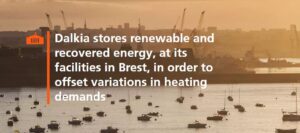The challenge: adapting continuous energy production to intermittent use

Brest Métropole (city of Brest and surrounding municipalities) is committed to the energy transition. Its heating network is powered by waste incineration and a biomass boiler system. The network heats the university, which experiences major spikes in demand. To provide heating at peak times without burning fossil fuels, Dalkia built France’s first thermal storage system connected to a heating network.

The solution: adding a thermal storage system to the heating network
The waste-to-energy facility and the new biomass boiler system continuously feed the heating network in the city, where heating demand can vary. To immediately absorb any spikes in demand, Dalkia built a 1,000 cubic-metre storage tank close to the university, which locals have come to call the “energy mirror”.
The tower provides an additional source of recovered energy totalling 2,500 MWh a year. The tower will be operated by Dalkia subsidiary Eco Chaleur de Brest, which holds the concession for the heating network.

How it works
The storage tower stands next to the university, a key location designed to better offset the high spikes in heating demand from the university in mornings and after weekends. A smart management system helps absorb these surges in demand as close as possible to the point of use. Renewable and recovered energy is stored when the waste-to-energy facility and biomass boiler system are on stream. It is then fed back into the network in short cycles of two to three hours to offset significant spikes in demand.
A project that promotes a circular economy
The Brest local authority chose to include customers and residents in the project from the outset. Dalkia contracted local companies to build the tower for similar reasons, providing a win-win situation by adding another social dimension to the project:
• Thermal engineering: CLIMATELEC, Cesson-Sévigné (35)
• Boilermaking: ORHAND, La Guerche de Bretagne (35)
• Structural metalwork: LOBLIGEOIS, Saint-Renan (29)
• Structural engineering: LEGENDRE, Saint-Herblain (44)
• Architecture: A3 ARGOUARCH, Brest (29)
Benefits:
Dalkia’s solution reduces fossil fuel consumption and greenhouse gas emissions while ensuring a secure supply of energy.
- Annual savings of 2,500 MWh, enough to heat 400 households
- CO2 reduction of 12,700 tonnes over 20 years
- 4,470 tons of oil equivalent replaced over 20 years
Key figures:
- Storage capacity of 1,000 cubic metres
- Commissioning: autumn 2016
- Cost: € 1.490.000
A significant piece of contemporary architecture
“When the engineers talked to me about their energy storage project, they told me the idea was to superimpose layers of water at different temperatures. So I imagined how I could use this interesting setup by transposing the water layers into mirror-finish stainless steel rings of different thickness that seem to sway and swing, reflecting the sky and the urban landscape—creating an energy mirror.”
Pierre Henri Argouarch, architect
Source: Dalkia